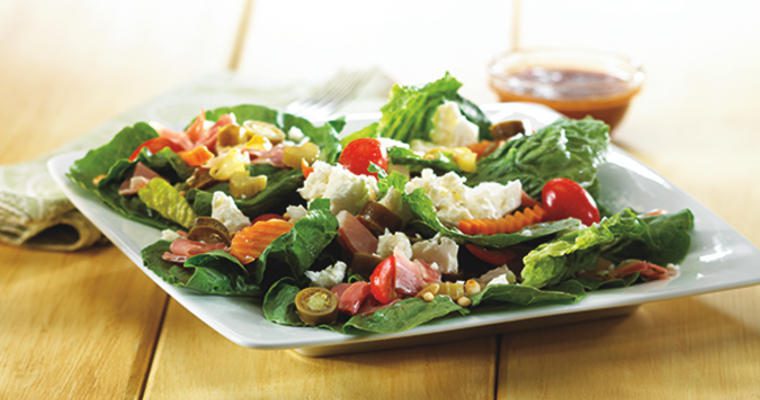Visionary chef Travis Lett opened Gjelina in Los Angeles six years ago. I visited the restaurant a few months later on a tasting tour, and at the time didn’t realize how revolutionary the restaurant really was. Right in the middle of the menu was a vegetable section with 15 dishes based on market produce.
Dishes like grilled nectarines with treviso, arugula, burrata, and prosciutto. Or roasted romanesco broccoli with anchovy, sofrito, and chili. These dishes were incredibly delicious, but I took them all at face value: a creative menu inspired by a creative chef. A few years later, things are percolating along and suddenly two new restaurants in New York City have adopted veg-centric menus. Then two more, the trend spreads to Chicago, and suddenly we’re seeing veg-centricity everywhere.
Spotlight on vegetables
Aside from Gjelina, two restaurants really jumped out with their commitment to veg-centric menus: Chalk Point Kitchen with Chef Joe Isidori, and Via Carota with Chef Jody Williams. Both restaurants have substantial “vegetables to share” menu sections that go way beyond the realm of side dishes. Each dish has its own style or a spin on an idea, and each draws from global cuisines.
Via Carota’s Italian focus brings dishes like an “Insalata di Arance” with blood oranges in vinaigrette, fresh basil, and red onion. The fennel confit shows off wedges of fresh fennel, slowly poached in a double-strength chicken broth served with sweet pepper relish and orange vinaigrette. Chalk Point Kitchen’s focus is more broad—you may find a dish of sweet-potato tempura with katsuobushi and ponzu next to a succotash of Pennsylvania-Dutch mushrooms, local corn, black-dirt carrots, and English peas with lemon-truffle vinaigrette—but it all comes back to the produce.
A new menu category is emerging. By holding vegetables in the high regard once reserved for proteins, chefs are using aggressive cooking techniques to bring out deep flavors in produce: roasting, grilling, smoking, and charring add sophisticated layers of flavor. This movement really has only two rules. The first is that many of these dishes use meat broths and bits as flavor enhancers and are not vegetarian. Veg-centric dishes celebrate the way a little meat makes food taste better while keeping produce at the forefront. The second is something I like to call “ABS”—Anything But Steaming. It adds absolutely zero flavor. It’s boring. Please—just say no. Beyond that, the opportunities are virtually unlimited.
Root-to-stem cooking
Food waste is a hot-button topic, and in a parallel mentality to the “nose-to-tail” movement, root-to-stem cooking uses the whole vegetable—minimizing waste, increasing margins, and inspiring new ideas. I confess that this concept was not on our radar, but talking to Chef Isidori turned us on to the benefits of whole-vegetable cooking. While Isidori is passionate about new flavor combinations, his greatest passion is achieving a “zero-waste” kitchen. He says it wasn’t long ago that he felt really good about composting, but now he strives to use vegetables in their entirety.
He is not alone in his quest; many chefs employ methods to use every last scrap. They roast and simmer vegetable peels into broth, use corn cobs to add light corn flavor and starchy creaminess to dishes, and dehydrate apple peels to powder them in a spice mill for a finishing sprinkle on desserts. Stems from greens and herbs, melon rinds, and odd bits of vegetables become pickles. Carrots aren’t peeled at all; they’re simply scrubbed and roasted in all their knobby glory. Carrot tops are used in place of parsley on certain dishes. Squash seeds are roasted and spiced. Broccoli stems and leaves are puréed into a green sauce for roasted broccoli florets. Turnip-green pesto finishes a dish of roasted turnips and maple-braised pork belly, a quintessentially veg-centric dish.
Produce maximizes seasonality
Fruits and vegetables speak to the seasons. They evoke emotions that run deep within our collective memory. Winter brings root vegetables, potatoes, or perhaps pickles and preserves put up over warmer months. Spring emerges with tiny green shoots, earthy mushrooms, and delicate greens. Summer cascades upon us in a bounty of color—tomatoes, corn, mountains of zucchini. Fall, of course, brings pumpkin-flavored everything but also hearty greens, heirloom apples, onions, and garlic. The sheer expanse of the palette available to us as chefs is awe-inspiring, and this sea change of veg-centric cooking brings unlimited opportunities. Viva la vegetable revolution!











